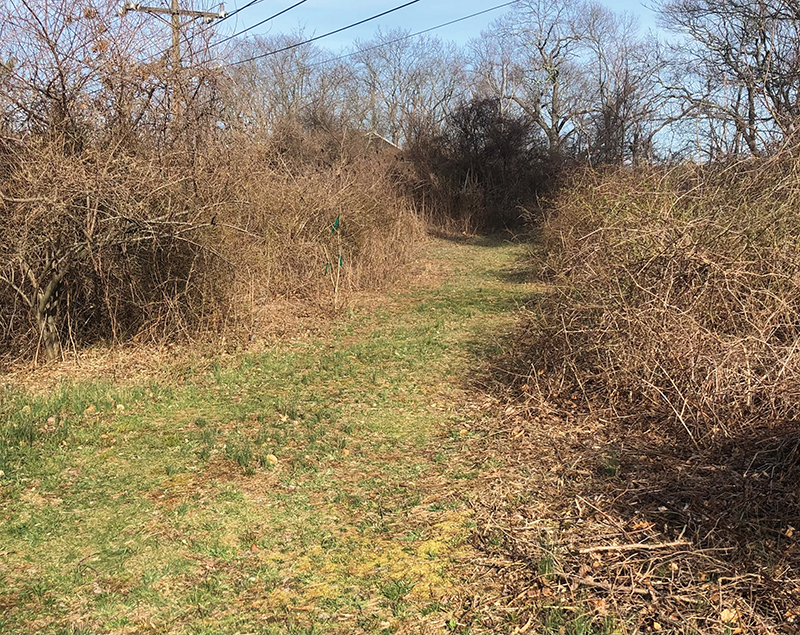

Old Saybrook Land Trust’s new habitat-rich acquisition. Image credit: Dick Shriver
This issue is dedicated to the Farmington River Watershed, a cornucopia of wonderful habitats for wildlife and mankind. Habitat means “home,” of course. Home to trout, bobcats, peregrine falcons, dragonflies, phytoplankton, moose, spruce grouse, and even beneficiaries of the Habitat for Humanity, promoted so ably by the memorable volunteer works of our last environmental President, Jimmy Carter. Habitat is a word we use often, though the context may vary considerably.
“Loss of habitat” is one of the most frequent causes cited for wildlife decline including birds and fish. Habitat refers not only to living quarters, but also to sources of food and water or to places where the animal world can propagate and find protection from predators. According to the Cornell Ornithology Lab, the bird population in North America has declined from nine billion some sixty years ago to six billion today. Other forms of wildlife have experienced similar declines. Much of the reason is land cleared to make roads, parking lots, and buildings, and the eradication of woods, fields, vernal pools, and other habitat-friendly surroundings, in the name of economic progress.
Any trout fisherman will tell you that trout favor places where the water is shaded, cooler, and momentarily deep, or where trees have fallen into the water. Stumps are even better; the stump of a tree dumped into a river, roots and all, can double the trout population along that stretch of river. The very spot one wants to place the fly is often the very spot where one’s line is most likely to get hung up on a root.
Hedgerows of trees, brambles, fallen branches, and wild berries may be nearly impassable for humans, but just what rabbits, pheasant, and quail need for protection. Bob Lorenz of the Old Saybrook Land Trust took me out recently to see a new acquisition, a narrow strip of land bordering on wetlands and covered with rough undergrowth, saplings, rank trees, and tangled vines—great cover for birds and small animals. While Many farmers around the world maintain hedgerows for wildlife, others till their fields right to the edge of a roadway or boundary line to squeeze in every inch of land for crops...thus eliminating an important habitat for wildlife.
Audubon Vermont’s Bobolink Program, in collaboration with Mass Audubon and Connecticut Audubon, addresses the habitat matter in a wonderfully practical manner. Depending on the weather in Vermont, fields of hay are mowed several times during a season to maximize hay production. During a predictable part of the season, however, mowing the hay also destroys the nesting places of bobolinks and their young. Through charitable donations, the Bobolink Program incentivizes farmers to skip a cutting during the crucial period that bobolinks need for their families to mature and depart before the heavy haying machinery moves in.
Not all wildlife habitats are hidden; many hundreds of nine-foot-high exposed man-built platforms have provided vital nesting habitat for Osprey throughout much of the Connecticut River watershed. Additionally, flood mitigation programs along the length of the Connecticut River and its tributaries also protect habitats for many four-legged creatures as well as plants and insects.
Many farmers and farmer-hunters plant seeds like millet and sunflower expressly for birds—especially dove and quail, not to mention smaller birds like towhees and juncos; farmers don’t harvest such crops, instead leaving the seeds for the birds.
But back to habitats for humans. Going beyond basic needs, the daughter of one wealthy businessman designed a house for her father’s retirement. Theodate Pope Riddle, one of the first licensed female architects in America, designed the Hill-Stead House in Farmington for her father, Alfred Pope (the Farmington River watershed is the theme for this issue of Estuary). Mr. Pope had an eye for great art, purchasing many now-world-famous works of art directly from the living artists themselves at the turn of the 19th century. Great art in the setting of an actual home is something to behold. Today, thanks to farsighted owners and years of work by countless volunteers and others—and for a modest entrance fee—anyone can experience what Alfred Pope enjoyed when he entertained or just relaxed in the same room with his amazing collection of Monets, Manets, a Cassatt, or a Renoir, an experience that is better realized in a home than in a museum.
May the richness of such man-made habitats help us to be more aware—and appreciative and protective—of our natural habitats.


Dick Shriver
Publisher & Editor

